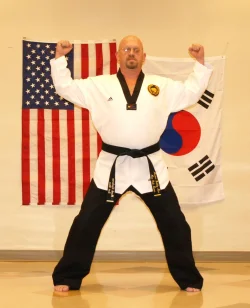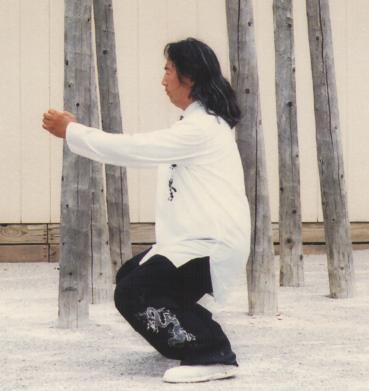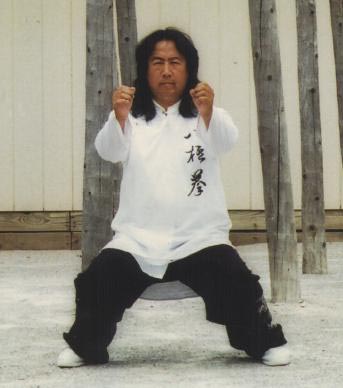Navigation
Install the app
How to install the app on iOS
Follow along with the video below to see how to install our site as a web app on your home screen.
Note: This feature may not be available in some browsers.
More options
Style variation
You are using an out of date browser. It may not display this or other websites correctly.
You should upgrade or use an alternative browser.
You should upgrade or use an alternative browser.
Horse stance?
- Thread starter Zoltan97
- Start date
Flying Crane
Sr. Grandmaster
Thanks, and yes this is fairly extreme, used for developing that leg strength.View attachment 20314
So this was the pic that popped up with the description on Google. I feel stupid (hopefully you all don't think I'm lazy for complaining!) but in our club we don't call it horse stance nor do we stretch with it. Maybe this picture is an extreme version of it?
This kind of training is often found within many of the Chinese methods, as it relates to the concept that powerful technique is delivered with a full-body connection and not, for an example, simply throwing a punch with the strength of the arm and shoulder alone. That full-body connection starts with the feet and leg, and drives power into the torso and down the arm to the fist. So developing strong legs is part and parcel to having powerful techniques.
It isn't just for punching either. Joint manipulations and grappling can also benefit from a full-body application of power, and that always comes back to having strong legs.
However, strong legs alone are not the answer. One also needs to work on how that strength is used, what movement and other mechanisms come into play in order to take advantage of that leg strength. So it is part of a larger training regimen and philosophy that is common to many of the martial arts. But not everything is done in this kind of deep horse stance. Application of technique can be from anywhere. But if you have built up that leg strength, along with an understanding of how to use it, then you can harness that power from any position.
Flying Crane
Sr. Grandmaster
Keep in mind, the term "Kung fu" does not mean fighting methods. That is a misinterpretation of the term. It actually means "skill acquired through hard work". That skill can be anything, including the fighting methods.
But my point is, it's HARD WORK.
All martial training, if done right, and if you intend to develop some genuine skill, is a whole lot of hard work.
But my point is, it's HARD WORK.
All martial training, if done right, and if you intend to develop some genuine skill, is a whole lot of hard work.
Midnight-shadow
3rd Black Belt
Some stances are used for fighting, others for training. The lower horse stance (in my opinion) is a training stance, to help strengthen the legs. I would never go into a lower horse stance during a fight because there are far better stances to use, but I still practice the lower horse stance for body conditioning.
This is how wide the "horse stance" used in the "hip throw".Okay, to me, horse stance (jigotai) is a wide stance.
One time I sparred with a Karate guy, I dropped into a low horse stance. Since my opponent was used to high kick (I don't think he had ever trained low kick), he didn't know what to do with me. Soon he gave up and said, "I hate to spar with you Kung Fu guys. You guys fighting stance are just too low".I would never go into a lower horse stance during a fight ...
When you drop down into low horse stance, you don't have much space to protect. When your opponent kicks at you, it's easy to grab his kicking leg, move in, and take him down. IMO, that's a good strategy and it's called "earth strategy" (earth against wood, low horse stance against kick).

IMO, this horse stance is too wide.
When you put your feet together, your base is small. You have poor balance. When your move your feet apart, you base is increased, your balance is also increased. When you have reached to one point and you further move your feet apart, even if your base is increased, you balance will decrease.
In other words, there is only one width that your horse stance can have the maximum balance, that will be about your "shoulder width".
View attachment 20314
So this was the pic that popped up with the description on Google. I feel stupid (hopefully you all don't think I'm lazy for complaining!) but in our club we don't call it horse stance nor do we stretch with it. Maybe this picture is an extreme version of it?
Not sure, but I use the chair stance. No idea if that is real or not, but I do it as if sitting in dinner table chair. The traditional wooden ones. Anyway I commend on the balence there, but are you're knees not screaming?
Not sure, but I use the chair stance. No idea if that is real or not, but I do it as if sitting in dinner table chair. The traditional wooden ones. Anyway I commend on the balence there, but are you're knees not screaming?
I'm not a 40 something year old man so I wouldn't know
I'm not a 40 something year old man so I wouldn't knowI got the pic off Google.
Huh, you ain't no whipper slapper for long, I can tell you
drop bear
Sr. Grandmaster
That would be outside the principles we use for the shoulder throw, which is why I asked. The waist belt doesn't allow the proper use of the uke's weight for our throw. We also use a narrower stance, rather than horse stance. And we simply wouldn't use a shoulder throw on someone significantly shorter - again, it violates some of our principles so isn't a good fit for NGA.
You can do it without landing on your knees. But you will have to have strong legs.
Last edited:
lol.. only if you have your weight centered correctly so that you feel it in your thighs and not in your knees. Weight over your knees has the opposite effect and works a different set of tendons and ligaments which aren't as strong to begin with.Well, crap, now you're going to tell me if I go back and do more horse stance practice, my knees might get better. Damn you, JGW.
Second thought. The correction on that may be it works the same tendons but at their weakest and not their strongest point and forces more pressure and tension on the ligaments. This is probably a more accurate statement without me breaking out body charts.
Muay Thai horse stance training?Maybe it is just the places I've trained, but the Horse stance seems to be a staple in MA
Horse stance, cross stance, cat stance training going on? Especially with the Tiger Steps boxing walk at 3:52. I guess it just depends on the type of Muay Thai school a person goes to as to how much significance the school puts on stance training place. My brother trains Muay Thai at his school and they don't do horse stance.
This picture would be extreme for Jow Ga Kung Fu. Students are taught that when it gets that low, it places unnecessary stress on the knees. The stance that the students train is something that we can move in and out of without changing the height of our stance. I should be able to go from horse to bow or to cat with ease without having to raise the level of my stance. If I need to move quickly I should be able to move in and out of that horse stance with very little problems.View attachment 20314
So this was the pic that popped up with the description on Google. I feel stupid (hopefully you all don't think I'm lazy for complaining!) but in our club we don't call it horse stance nor do we stretch with it. Maybe this picture is an extreme version of it?
I thought I was the only one who gets a kick out of doing that to people. The low stance throws a lot of people off and everything that you stated is true, so please stop telling those types of secrets lol. I always enjoy how they freeze as if they are trying to solve a puzzle, because I know at that point I could unleash a lot of other things while they are sitting there being stunned lol.One time I sparred with a Karate guy, I dropped into a low horse stance. Since my opponent was used to high kick (I don't think he had ever trained low kick), he didn't know what to do with me. Soon he gave up and said, "I hate to spar with you Kung Fu guys. You guys fighting stance are just too low".
When you drop down into low horse stance, you don't have much space to protect. When your opponent kicks at you, it's easy to grab his kicking leg, move in, and take him down. IMO, that's a good strategy and it's called "earth strategy" (earth against wood, low horse stance against kick).
View attachment 20314
So this was the pic that popped up with the description on Google. I feel stupid (hopefully you all don't think I'm lazy for complaining!) but in our club we don't call it horse stance nor do we stretch with it. Maybe this picture is an extreme version of it?
I'd consider that an extreme example, yes.
Anything we teach as a "stance" would be something you can move in and out of quickly, during sparring or fighting. That's not true of something that deep. It IS could exercise to stay in that position, though. We do an exercise where students drop about that low, then come up and throw a kick.
We teach the Horse Stance like this. Ignore the arms; this is taken from my 2nd book and shows one of the techniques in Keumgang.

Similar leg movements for us - the transitional stance would possibly be wide (depending upon distance to their midpoint, of course). We just use a narrower stance for the throw.This is how wide the "horse stance" used in the "hip throw".
That would have some advantages. It would also mean I could finally try to kick you in the head.One time I sparred with a Karate guy, I dropped into a low horse stance. Since my opponent was used to high kick (I don't think he had ever trained low kick), he didn't know what to do with me. Soon he gave up and said, "I hate to spar with you Kung Fu guys. You guys fighting stance are just too low".
When you drop down into low horse stance, you don't have much space to protect. When your opponent kicks at you, it's easy to grab his kicking leg, move in, and take him down. IMO, that's a good strategy and it's called "earth strategy" (earth against wood, low horse stance against kick).
Interesting. Our jigotai ("horse riding stance" is the translation, I think) is about this wide, but not nearly as deep in most circumstances.
IMO, this horse stance is too wide.
When you put your feet together, your base is small. You have poor balance. When your move your feet apart, you base is increased, your balance is also increased. When you have reached to one point and you further move your feet apart, even if your base is increased, you balance will decrease.
In other words, there is only one width that your horse stance can have the maximum balance, that will be about your "shoulder width".
Similar threads
I
- Replies
- 18
- Views
- 2K


